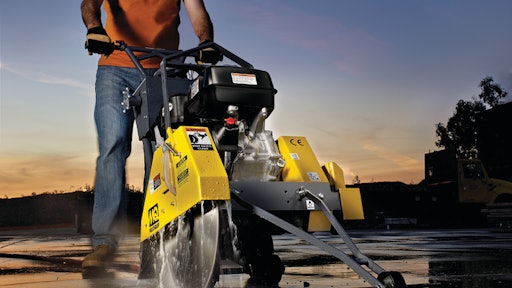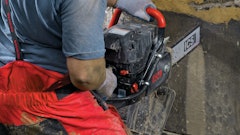
Concrete cutting tools take a lot of abuse, simply by nature of the type of work they do, but proper care and maintenance of your saws will go far in ensuring they remain loyal servants in your equipment inventory for a long time to come. Following are some suggestions to help keep your floor, street and cut-off saws in tip top shape.
On a Daily Basis
One of the most important things you can do to keep your saws in great condition is unbelievably simple: Keep them clean. Normal wear and tear is always going to be there, but a lot of what you see when a saw comes back from rent is simply due to the machine not being thoroughly cleaned. The sawing process and water combine to create a slurry mixture that coats the sides of the machine. A good wash down at day's end with a pressure washer or hose will remove any buildup, keep the saw looking good, and allow you to give it a thorough inspection before the next rental.Next, always give the saw a thorough inspection before renting it to a customer. If you can catch a bent arbor shaft or a loose blade before starting up the machine, you can prevent damage and decrease the need for an extensive repair.
Likewise, a little lubrication goes a long way. Keeping the blade shaft bearings lubricated is one of the most important daily maintenance procedures. These bearings should be greased at the end of every work day. Many experts recommend giving each bearing two pumps of grease while the machine is still warm from operation, if possible, and while the shaft is turning over at idle speed. It's important to note that over greasing can blow out the bearing seal and ruin the bearing, so don't overdo it.
Oil levels should be checked daily. With dry cutting, you may need to change oil more frequently than you would with wet cutting because of the ingestion of dust in the engine.
Making sure the blade shaft belts maintain the proper tension is also important. With new saws, it's a good idea to run them an hour or so and then retighten the belts. But like greasing, avoid going overboard. Over-tightening the belts could damage the belts and bearings. After that, routinely check the belt tension until the belts have stretched to their limit.
Many experts say belt tension is the most important part of maintenance on concrete saws. If the belt happens to slip, saws can vibrate dramatically. Vibration can lead to premature wear to components, damage to the saw's frame, and reduced blade life. A squealing sound is another indication that a belt is slipping. At that point, the belt needs to be tensioned immediately to avoid wear and potential damage.
Lessen the Abuse
Sawing concrete creates especially difficult operating conditions for saws. Even when wet sawing, concrete generates fine dust particles that can easily make their way into bearings.
With this in mind, operators should hit lubrication points daily and routinely clean the engine air filter. Again, it's important to check belt tension, especially when cutting expansion grooves or using a saw in other tough conditions, as a loose belt will reduce blade rpm and shorten blade life. Cutting a groove too deep, more than one or two inches in a pass, or cutting too fast can also damage blades, so be sure to go over these points with customers before your saw goes out on a rental.
Air cleaner maintenance changes according to whether you're cutting wet or cutting dry. It's important to set a maintenance schedule either way, but in dry cutting you'll have dust to contend with. Dust gets lodged in air cleaners and is tougher on belts and bearings so it needs to be cleaned and maintained on a daily basis. With wet cutting, air cleaners need to be checked only once a week.
When wet cutting, water is the lifeblood of a fast-turning blade and it works to suppress dust. Without adequate water, blades can overheat, warp and ruin the cut. Part of any service regimen should include checking the water delivery system prior to rental, and making sure tubes are free of dirt or debris. This is especially important if the water source is questionable. It's a good idea to hook up the water prior to sending the machine out on a rental to make sure it is running freely onto the blade. If using a wet-cutting blade, always make sure you've got proper water flow. Check that each of the two coolant tubes located on either side of the blade are not damaged or pinched shut. This will ensure adequate water flow to properly cool the blade.
Again, lubrication and routine inspection are both critical to saw performance and longevity. As such, arbor bearings should be lubricated daily to purge concrete particles that naturally make their way into the bearing. The blade should also be checked every day to ensure it is tight and free of cracks or loose segments.
Caring for the Blade
When it comes to caring for the blade, there are several things to keep in mind. Ensuring that you have the right blade for the job is at the top of the list.
The important thing to remember when renting the saw to a customer is matching the blade to the application and letting the saw do the work. Always rent your customers the correct blade for asphalt, green concrete or cured concrete, and likewise, for wet cutting versus dry cutting. Tell customers to let the cutting speed dictate their travel speed, and not force the machine through the cut.
Since your saw's blade and arbor will carry most of the work load for the day, make sure the blade is tight and in good condition before releasing the saw to your customer.
At the end of the day, the belts and blade have the greatest impact on the performance of a saw. Slipping belts will result in slower cutting speeds and a loose drive change will prevent the machine from moving forward at the most efficient feed rate. Get the most out of your concrete saws by ensuring they get the care and maintenance they need.
Information provided by Multiquip, Wacker Neuson and Saint-Gobain Abrasives/Norton Construction Products.

















![[VIDEO] What Sets Hilti Gas Saws Apart from the Competition](https://img.forconstructionpros.com/files/base/acbm/fcp/image/2016/02/default.56ba5dbbe44d5.png?auto=format%2Ccompress&fit=crop&h=135&q=70&w=240)








